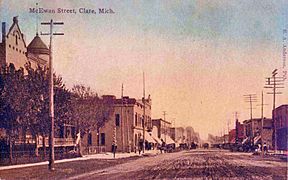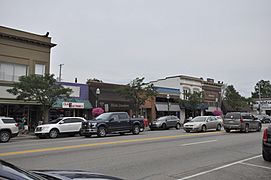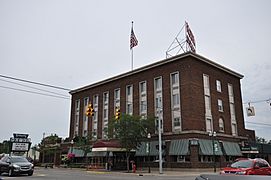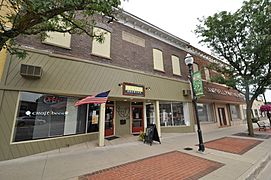Clare Downtown Historic District facts for kids
Quick facts for kids |
|
|
Clare Downtown Historic District
|
|

McEwan and Fourth, 2017
|
|
| Location | 114-120 E. Fifth St., 102-202 W. Fifth St., 112-115 E. Fourth St., 112-124 W. Fourth St., 307, 321-622 N. McEwan, Clare, Michigan |
|---|---|
| Architectural style | Neoclassical and Commercial Brick |
| NRHP reference No. | 16000178 |
| Added to NRHP | April 19, 2016 |
The Clare Downtown Historic District is a special area in Clare, Michigan. It has 51 old buildings that tell a story about the town's past. These buildings are found along North McEwan Street and nearby parts of East and West Fourth and Fifth Streets. This historic district was added to the National Register of Historic Places in 2016. This means it's an important place that helps us remember American history.
Contents
Discovering Clare's Downtown History
The story of downtown Clare began in 1864. A man named William McEwan bought a lot of land here. He was a lumberman from Bay City. In 1868, he set up a logging camp. Workers started cutting down trees in the area.
How Clare Grew from a Logging Camp
In 1870, something big happened. The Flint and Pere Marquette Railroad built tracks through the area. These tracks crossed a main road near McEwan's camp. McEwan saw a great chance to build a town. By the end of 1870, Clare had its first buildings. There were places to stay, a store, and some homes.
Clare's Fast Growth in the 1870s
The town's business area grew very quickly. By 1878, Clare had about 700 people living there. It also had over 30 businesses. There were two churches and many jobs in factories. In 1881, an opera house opened for shows. The first brick building in Clare was built in 1885.
Modern Changes and City Status
Soon, Clare got public water pipes and telephone lines. By 1891, nearly 1,200 people lived in Clare. It officially became a city that year. Electricity came to Clare in 1894. Many important brick buildings were built downtown in the 1890s. One of the biggest was Alfred Doherty's large store building.
Fires and New Buildings in Clare
In the early 1900s, two big fires happened. One was in 1904 and another in 1907. These fires destroyed many wooden buildings downtown. But the town quickly rebuilt them. From then on, all new buildings were made of brick. Smaller fires happened later, too. This led to new buildings being built from the 1920s to the 1990s.
Building Up West Fifth Street
More construction happened in the 1930s. This was along West Fifth Street. It followed the building of the Clare City Hall. Downtown Clare did very well until the 1960s. That's when a new highway bypassed the city. Even with some challenges, the downtown area still has many active businesses today.
Exploring the Downtown Historic District
The Clare Downtown Historic District is right in the middle of the city's business area. It stretches along four blocks of North McEwan Street. It also includes parts of East and West Fourth and Fifth Streets. There are 51 buildings in this district. There are also two other structures and two special sites.
What the Buildings Look Like
The buildings were built between 1873 and 2000. Most are two stories tall. But some are one story, and one is four stories high. Many buildings show a style called Neoclassical. Others are in the Commercial Brick style. You can also see some Late Victorian and Mid-century modern designs.
Key Areas of the District
The very south part of the district has a large elevator building. It's on McEwen Street, just south of the railroad tracks. The main part of the district is along McEwen. It's between Third Street and Sixth Street. The buildings here are mostly one or two stories. They are commercial buildings, standing close together. They face right onto the sidewalk.
The Famous Doherty Hotel
On the corner of McEwen and Fifth Street, you'll find the Doherty Hotel. It was built in 1924. This is the only four-story building in the district. The original Doherty Hotel and its parking lot take up a whole city block. This block is between Fifth and Sixth Streets, and McEwen and Pine Streets. North of the district, there's a large modern hospital complex.
Streets Beyond McEwen
The district also goes along Fifth Street in both directions. To the east, it includes the Herrick House, built in 1882. This used to be a house but is now used for businesses. To the west, the district includes the US Post Office and Clare City Hall. The Clare Congregational Church is also here. It's so important it's listed separately on the National Register. The district also goes west along Fourth Street. This part has a group of commercial buildings.
Images for kids








